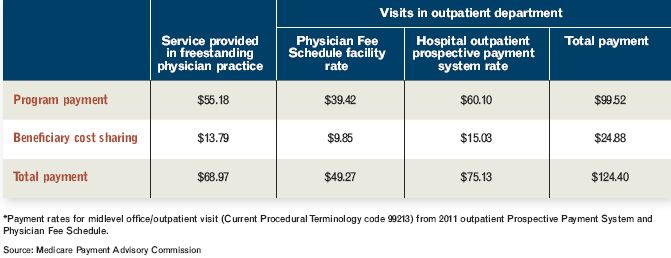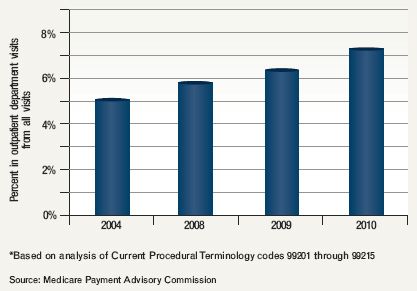Article
Facility fees can change the economic equation
Facility fees are controversial. Discover how they can alter your practice's economics.
As more hospitals acquire physician practices, some doctors are moving into freestanding health centers that offer multiple clinical services. Many hospitals are creating such state-of-the-art facilities in off-campus locations and having them designated as outpatient departments, thus allowing them to send separate facility fee bills to patients. At times, existing facilities are being updated and reclassified as a hospital system acquires a practice, enabling a system to charge a new fee to returning patients.
Although national data appear not to have been gathered on how many hospitals are now charging facility fees, it is clearly an increasing trend. (See “Office to outpatient department visit shift” for more information.) For example, one major hospital system, the Cleveland Clinic, has changed 12 of its 16 regional family health centers into outpatient facilities.
The practice is so controversial that several institutions and organizations representing physicians declined to discuss it with Medical Economics.
Critics argue that the facility fee trend is counter to the nation’s goal of reducing healthcare costs, whereas supporters say it is necessary to maintain the “standby” services that provide prompt and convenient access to diverse care in one location.
“We have a cost problem in the United States,” says Robert Zirkelbach, spokesman for America’s Health Insurance Plans. “Prices for services are driving the rise in healthcare costs at unsustainable rates. If we are going to bring down costs, we have to get hold of this.”

Anders M. Gilberg, senior vice president of the Medical Group Management Association (MGMA), says that MGMA generally believes that if the quality of care is the same in a typical office as it is an outpatient center, then the payment should be equal.
“Facility fees are a way to allow hospitals to earn more for a simple office visit,” he says. (See “Setting-based differences in payments and cost-sharing” for more information.)
Critics also say that the payment of higher fees in certain settings only encourages providers to move toward those more costly settings and is contrary to other trends in healthcare, such as forming accountable care organizations to bring efficiency to healthcare delivery.
Gregory A. Hood, MD, FACP, an internist in Lexington, Kentucky, governor of that state’s chapter of the American College of Physicians, and a member of the Medical Economics editorial board, calls facility fees a clear abrogation of the system.
“They present a markup, which is unjustifiable in today’s healthcare. They provide revenue through the hospitals that are able to lure physicians into employed agreements, with which private practices cannot compete to hire new talent. This is a part of the dramatic decline in private practice ownership in recent years,” he says.

“If [the Centers for Medicare and Medicaid Services] and the administration are serious about eliminating waste in healthcare, they will eliminate the facility fee as soon as possible,” Hood adds.
In fact, the Medicare Payment Advisory Commission (MedPAC) estimates that facility fees for office visits will add $2 billion a year to Medicare spending by 2020, and Gilberg says MedPAC is looking into ways to achieve more equality in payments.
This effort could include basing payments on the most efficient use of clinically appropriate resources needed to treat patients. The U.S. House of Representatives passed a bill along these lines, but it stalled in the Senate.
Representatives of MedPAC did not respond to numerous requests by Medical Economics to discuss its position on the issue.
‘Soup to nuts’approach valuable

To be sure, not everyone is critical of facility fees. Erik Rasmussen, senior associate director of federal relations for the American Hospital Association, defended the creation of hospital outpatient facilities, saying they offer a level of coordinated care that many patients appreciate. (See “Medicare requirements for facility fees” for more information.)
“These are places where you can go to get ‘soup to nuts,’ ” he says. “Some patients like having everything in one place and won’t be scared off [by additional fees]. A patient who wants to see a trusted provider values that. Many issues drive where patients go for care. This is not a top-tier driver.”
Facility fees are needed to cover “stand-by” costs associated with having additional services available on site, he says. “If those capabilities are not paid for, they will not be there when we need them,” Rasmussen says.
He adds that hospital facilities see all patients, regardless of ability to pay, which is not true of many private physician offices. That approach, he says, further justifies facility fees.
Eisenhower Medical Center’s Annenberg Center for Health Sciences in Rancho Mirage, California, is an institution that has licensed its clinics as outpatient centers. Joseph E. Scherger, MD, MPH, vice president for primary care and academic affairs there, says that Medicare pays the facility fee, as do some insurers.
“While the fee drives up the charges for care, they are important for sustainability of these clinics,” says the member of the Medical Economics editorial board. “Hospital clinics must meet all Joint Commission requirements for accreditation. This results in added overhead expenses that would not be covered by the ordinary professional fee.”
For example, these clinics must have a registered nurse on site and have special storage and reporting of all medications, he says.
“Hospitals get a facility fee for all their settings, such as the emergency department and other locations such as a surgery center,” Scherger says.
Affecting the marketplace
Michael Fox was business director for Mercy Health Partners in Muskegon, Michigan, before becoming a management consultant with Rehmann’s Healthcare Management Advisors in Muskegon and Grand Rapids. He says many independent physicians believe that the practice of charging facility fees gives hospitals a financial edge in the market through additional revenue with no increase to overhead.
Fox says that in his local market, most practices purchased by a hospital have become provider-based clinics. The additional revenue provided from the facility fee flows primarily to the hospital’s bottom line, although some of it may be factored into the compensation models used to pay providers, he says.
He notes that the increased patient out-of-pocket expenses resulting from the fees have not resulted in an exodus of patients from the provider-based clinics to the remaining independent practices in the area, which could indicate that patient loyalty is greater than any dissatisfaction produced from additional co-pays.
He predicts that provider-based clinic growth will persist as more large hospital systems continue their aggressive hiring of specialists, but he also believes the Office of the Inspector General most likely will begin targeting them for compliance audits as well.
Fox does not believe that the ability of hospitals to charge facility fees is encouraging physicians to sell their practices, however.
“The primary drivers behind physician employment offers from hospitals appear to be referral capture, recruitment and retention, clinical integration, and accountable care organization development,” he says.
Patricia J. Roy, DO, a family practitioner in Muskegon, Michigan, and a client of Fox’s, agrees that higher fees flowing to hospitals aren’t motivating physicians to sell.
“I think most physicians selling their practices to hospitals are motivated by the guaranteed base salary and the diminished hassles of ‘administrivia,’ ” says the member of the Medical Economics editorial board. “They like the idea of the doctors being paid first rather than last.”
Know what you are getting into
Gilberg advises doctors who are considering selling their practices to hospitals to fully understand the implications of how patient billing could change. Patients who see their doctors at such sites can be caught off guard-and angered-when they receive two bills (or one bill that includes two separate charges for one visit) that have a sum total that often is substantially higher than they are accustomed to receiving for an office visit.
If you enter into this type of work situation, expect to hear complaints, especially from uninsured patients or those with high-deductible policies who may owe several hundred dollars for care that previously only cost them a routine co-pay.
“You do not want to anger patients, especially if you have a long-established practice,” Gilberg says. “It can become a big problem.”
Be sure to do your homework to learn the plans of the hospital system with which you are negotiating, because not all physician practices that are acquired by hospitals will enter into this type of arrangement, he explains. Facilities need to be brought up to certain standards and meet regulatory criteria to allow the outpatient facility designation (see “Medicare requirements for facility fees”), and systems sometimes determine that it is not worth the investment, he says.
“You can’t just flip a switch and become an outpatient center,” Gilberg says.
Communicating the change
While the government and professional organizations advocate for a payment system that is fair to all participants, physicians are faced with the task of maintaining positive patient relations and sufficiently sized patient panels so that their practices remain financially viable.

If you are considering joining a system that assesses facility fees, also consider asking your patients whether such fees would affect their choice of physician. Regardless of whether you include patients’ opinions in your decision, if you have joined or plan to join a system that assesses facility fees, be sure to inform your patients of the change before they come in for an office visit, Zirkelbach advises.
Telling patients, he adds, is the obligation of whomever is providing the services.
“Transparency is crucial to letting patients make informed decisions,” Zirkelbach says.
“Patients want the best healthcare they can get at the best price, but sometimes, patients pay more and get quality that is no better. Informing patients is particularly essential when the practice ownership and its billing policies have changed,” Gilberg says. “There should be no ambiguity. The practice has an obligation to its patients, especially since the [financial] benefit here is to the hospital.”
Although it may be difficult for you to provide patients with an exact estimate of fees before you actually see them, you can forewarn them about how the billing will occur (for instance, that they will receive two bills, one from you and one from the hospital system, if that is the case), he adds.
In an example of expectations clashing terribly with billing policies, a family in St. Louis, Missouri, filed a class action lawsuit earlier this year against Tenet Health Systems, which the family said tacked misleading and deceptive fees onto bills for patients seen at Saint Louis University Hospital and Des Peres Hospital.
Although the hospital is the one that gets sued in such instances, the doctors’ reputations suffer in the process, Gilberg says.
If you are the competition
If you are a private practitioner and a new hospital-affiliated multiple-service facility opens near you, the one-stop-shopping option it offers can be very attractive to your patients.
Although it might be a marketing opportunity for you to position yourself as a better value if you adhere to traditional billing practices, do a little legwork to learn more about the new facility first, and take these additional steps, advises consultant Judy Bee of Practice Performance Group in La Jolla, California:
- Confirm whether facility fees will be assessed at the other facility.
- Encourage patients who bring up the subject of the new facility to ask a few questions of their own, such as whether their insurance covers such a fee, or will it become their responsibility? Will they get to see the same physician at every visit, or will they see a changing mix of midlevel providers?
- Tell patients who are considering switching that you understand their perspective and you will gladly make their records available to another provider if they want you to do so, but stress that they are welcome back at any time.
Patients expect additional fees when they go to emergency departments, but not when the location of their visit looks like a doctor’s office, especially if they’ve been visiting a doctor at the same building with no additional charges assessed previously, says Bee, a Medical Economics editorial consultant. She predicts that many will seek out a more traditional practice arrangement once they learn more.
Knowing your competitive advantages will be crucial at such a time, she says. “These clinics have good doctors, too, so be sure your service and face-to-face contact are making your patients happy,” Bee adds.
Setting-based differences in payments and cost-sharing*

*Payment rates for midlevel office/outpatient visit (Current Procedural Terminology code 99213) from 2011 outpatient Prospective Payment System and Physician Fee Schedule.
Source: Medicare Payment Advisory Commission
Office to outpatient department visit shift*

Send your feedback to medec@advanstar.com. Also engage at www.twitter.com/MedEconomics and www.facebook.com/MedicalEconomics.
Medicare requirements for facility fees
Hospital outpatient departments must meet Medicare’s standards for “provider-based” departments or clinics to bill Medicare a facility fee under the outpatient prospective payment system, according to the Medical Group Management Association.
Here are some highlights of the standards, according to the organization:
Licensure. The department and the hospital must be operated under the same license (except in cases in which a state requires a separate license for the entity or department, or in states that do not permit licensure of the hospital and the department under a single license).
Clinical integration. The department and the hospital must be clinically integrated, as evidenced by all of the following:
- Members of the professional staff of the department have clinical privileges at the hospital.
- The hospital must maintain the same monitoring and oversight of the department as it does for any other of its departments.
- The medical director of the department must maintain the same reporting relationship with the chief medical officer of the hospital as does the medical director of any other hospital department, and he or she must be under the same type of supervision and accountability as any other director.
- Hospital medical staff committees are responsible for the medical activities in the department, such as quality assurance and utilization review.
- Medical records for the department and the hospital are integrated into a unified retrieval system (or cross-reference) of the hospital, meaning that practitioners at both the main provider and department must be able to obtain relevant medical information about care at the other location.
- Inpatient and outpatient services of the hospital and the department are integrated, and patients of the department who require further care have full access to and are referred to the appropriate department or service of the hospital.
Financial integration. The department and the hospital must be financially integrated, as evidenced by shared income and expenses.
Public awareness. The department must be held out to the public and to other payers as part of the hospital. When patients enter the department, they must be aware that they are entering the hospital and will be billed accordingly.
EMTALA compliance. The department must comply with the applicable anti-dumping requirements of the Emergency Medical Treatment and Active Labor Act.
Site-of-service code. Physician services provided within the department must be billed with the correct site of service (hospital outpatient) so that appropriate payment for doctors and practitioners can be made.
Consistent treatment. For billing purposes, the department must treat all Medicare patients as hospital outpatients.
Payment window. If a patient is admitted to the hospital as an inpatient after receiving care in the department, then payments for services provided in the outpatient department are subject to the 3-day payment window provisions such that outpatient diagnostic services related to the admission furnished by the admitting hospital within 3 days immediately preceding the beneficiary’s admission are deemed to be inpatient services and included in the inpatient payment.
If the department is located off of the hospital’s campus, additional requirements apply, such as:
Operations. The department must be operated under the ownership and control of the main hospital provider, as evidenced by the following:
- The hospital owns 100% of the business enterprise that constitutes the department.
- The hospital and the department must have the same governing body.
- The department must be operated under the same organizational documents as the hospital.
- The hospital must have the final responsibility for administrative decisions, as well as final approval for contracts with outside parties, personnel policies, and medical staff appointments.
Administration and supervision. The reporting relationship between the department and the hospital must have the same frequency, intensity, and level of accountability that exists in the relationship between the hospital and any one of its existing departments.
- The department must be under the direct supervision of the hospital.
- The department must be operated under the same monitoring and oversight by the hospital as any other hospital department, and it must be operated just as any other hospital department with regard to supervision and accountability.
- The following administrative functions of the department must be integrated with those of the hospital: billing services, records, human resources, payroll, employee benefits, salary structure, and purchasing services.
Location. Generally, the department must be located within a 35-mile radius of the hospital’s campus.





